Antique trunks are rarely talked about these days, but they are an incredible asset at home, and back in the day, they were a fantastic option for travel.
So, did you recently inherit an old wooden trunk? Or maybe you are interested in buying one to beautify your home?
Well, you don’t have to worry because I have all you need to identify your trunk’s age, value, and make. Military antique trunk identification? It’s here. 1920 Steamer trunk value? It’s also here. This article contains a complete identification and value guide for antique trunks. Read on to find out more.
Table of Contents
The History of Antique Trunks
Trunks have existed for a long time, and their history is quite interesting. They come in different shapes, sizes, colors, and eras. The best part about these trunks is how each feature and detail tells a story about the history and craftsmanship of the baggage.
These stories, features, and incredible detailing are what made trunks famous in the past and what makes them so exciting now.
You can find antique trunks dating back to medieval times. However, antique trunks became popular about 150 years ago during the Victorian Era. They were first seen and used around 1870.
The invention of antique trunks came about around the time of road and sea travel through steam-powered trains and ships. Therefore, these trunks were used to hold a considerable amount of personal belongings during transit.
Antique trunks were first used on some of the most iconic ships in the world, such as the RMS Queen Elizabeth and the Titanic.
In the beginning, most of these trunks were made from pine wood and were beautified using animal hide. They could be as tall as 14 inches or as heavy as 100 pounds.
However, as time went on, their designs changed, and antique trunk manufacturers started covering them with leather, canvas, or some kind of metal exterior. Also, manufacturers started making them with compartments, drawers, and hangers to increase their functionality.
Antique trunks trended for a good 55 years before trunk makers created other types of portable suitcases. You can still find antique trunks today. You can find both older models from the 19th century and newer models made by well-known brands such as Louis Vuitton, C. C Footlocker, and Martin Maier.
How do you Identify an Antique Trunk?
Nowadays, there are several reasons why we no longer use antique steamer trunks as luggage, one of which is airline restrictions.
However, people still enjoy collecting and using them at home. People can use a steamer trunk as a dresser, cabinet, coffee table, or simply as a storage unit. Luckily, there was a massive production of steamer trunks over the past few decades, so there’s enough to go around.
Sadly, antique trunk identification can be difficult, especially if you do not know much about steamer trunks. So, read on to find out how to identify antique trunks.
- First of all, for a steamer trunk to be considered antique, it needs to be at least over 100 years old and not have been restored.
While a restored antique steamer trunk is not as valuable as one that wasn’t, it has some value. That said, it is best to look for adequately restored trunks.
- Secondly, people use steamer chest and steamer trunk synonymously, which isn’t surprising because you can use a steamer trunk as a steamer chest. Besides that, they have certain similarities. However, they do have differences. Here are some of these differences:
- Even though trunks are pretty heavy and need two people to lift them, they are usually lighter and more portable than a steamer chest.
- Trunks were designed for travel, so they have a more practical design, as opposed to chests that were simply made for decorative purposes.
- Trunks are usually simple and have minimal designs, whereas chests have numerous details.
Here’s a link to a YouTube video explaining some tips and facts on antique trunks.
Types of Antique Trunks
If you already own an antique trunk or want to know more about trunks, you should know that there are several types. Below you will find a few of them.
Remember that there are numerous types of antique trunks, and if you do not find yours on this list, you can post a picture of it on specific forums, and someone will answer your inquiry.
Flat-Topped Trunks
This is probably the most common type of antique trunk. As its name suggests, most of these trunks have flat tops and were used mainly for travel. Their shape made them easy to stack and store on ships, carriages, and trains.
They were made using canvas, leather, wood, or metal detailing. In some cases, these trunks would be wrapped in waterproof fabric. Furthermore, these trunks were affordable, and even average-class people could afford them.
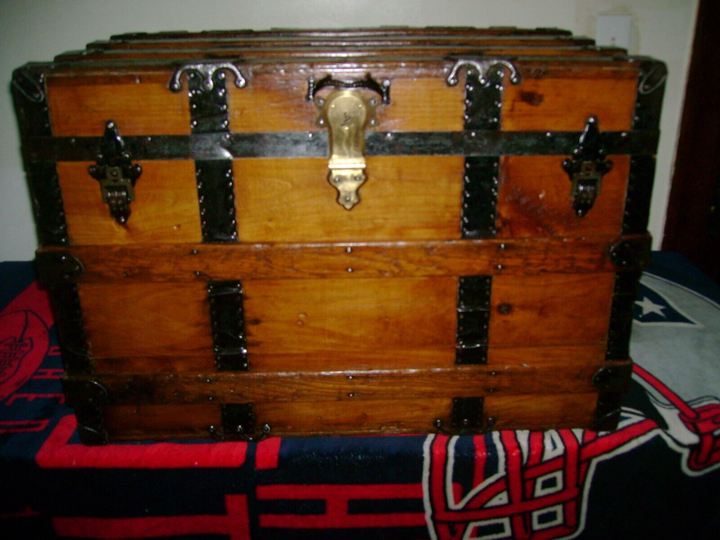
Jenny Lind Trunks
These trunks became popular in the 1850s and 60s. They were named after a famous Swedish singer, Jenny Lind. While touring the US for two years, she carried around a unique-looking trunk.
The trunk looked like a loaf of bread from the side because the middle curves inward where the trunk latches. Most times, these trunks came with bands of brass and large studs. When her tour ended, manufacturers created copies of her trunk, and many people purchased it.
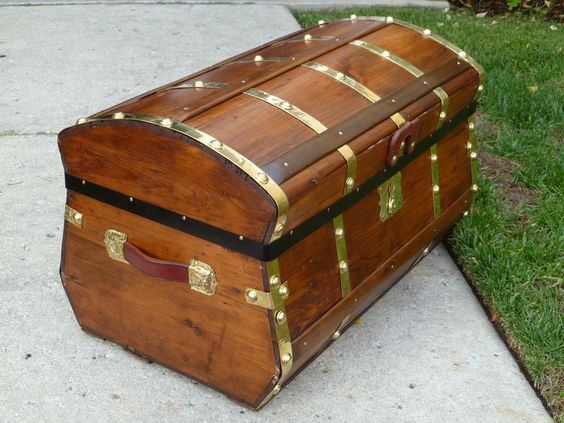
Dome-Topped Trunks
Just like flat tops, dome-topped trunks were named after their shape. They had domed tops, which meant they were not preferable for travel. Furthermore, they were created with attractive designs; therefore, they were pricier, and only the wealthy could afford them.
These days, you can find them in homes as furniture.
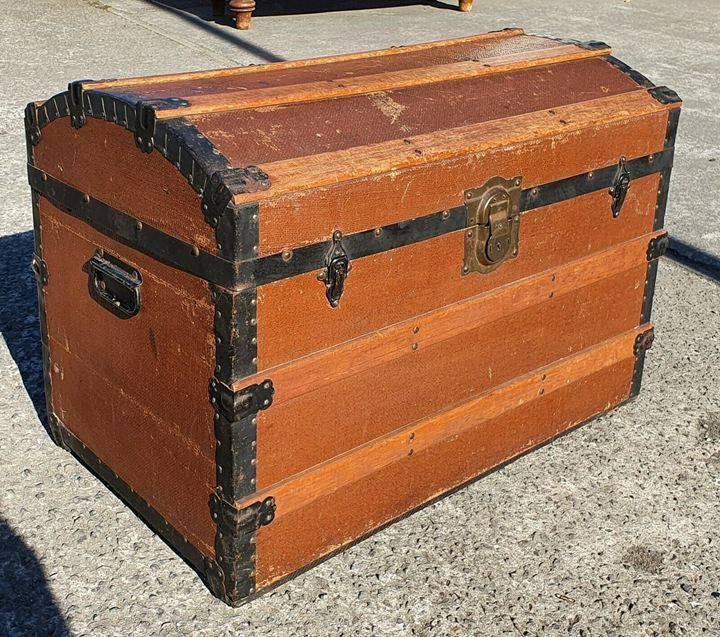
Slatted Trunk
These trunks were known for their elegant craftsmanship. They were made with thin wooden slats arranged next to each other to create a cuboid shape. These trunks had a sturdy construction, and some trunks may also come with a curved top.
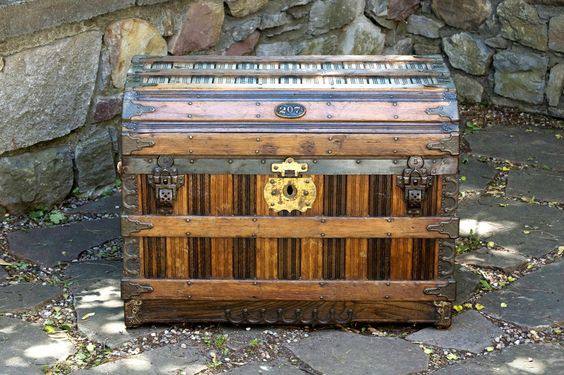
Travel (Steamer) Trunk
Travel or steamer trunks, as their name suggests, were designed mainly for travel. Their design made them perfect for fitting into tight spaces.
Unlike other trunks, antique steamer trunks were made to stand on their sides on a flat surface. This means they would stand upright, and users would open the trunks outwards. Inside these antique steamer trunks, you would find several drawers, compartments, or a tray inside.
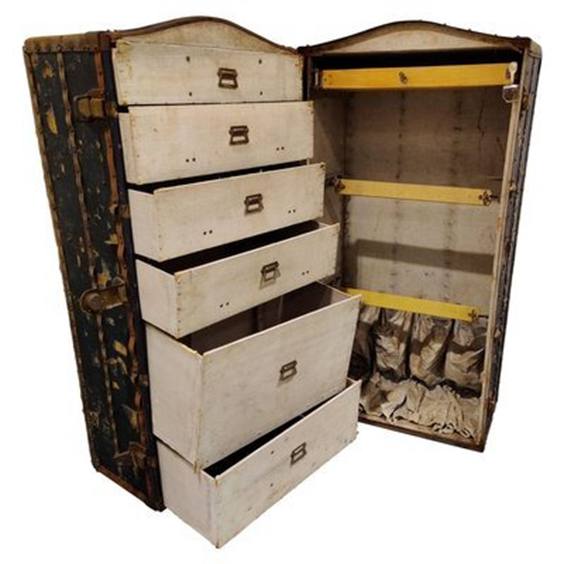
Saratoga Trunks
Saratoga trunks were named after a vacation spot in the 1800s. Saratoga, New York, was a popular place for wealthier people to go and relax. Due to the nature of this spot, these trunks were made to showcase the affluence and extravagance of the owners.
Saratoga trunks had round tops and were covered in leather, metal, or canvas. You could also find them covered with decorative hardware.
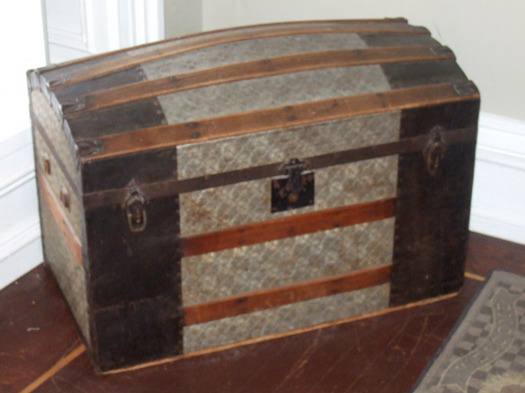
Wall Trunks
Wall trunks were made to look like every other regular trunk with one exception, their hinges. Wall trunks were designed to be stored in small spaces because their hinges allow you to push them against the wall and still open them without having to leave space between the wall and the trunk.
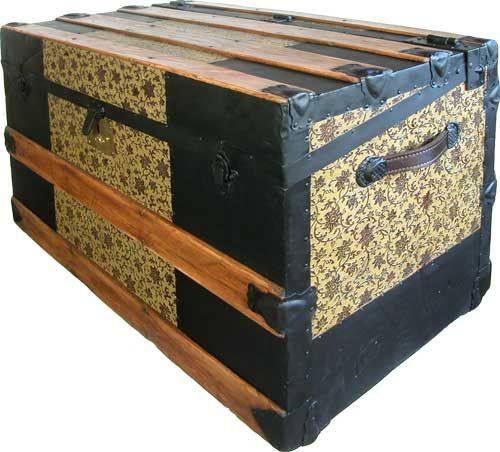
Popular Antique Trunk Manufacturers
Trying to decipher the origin of your trunk might be difficult or maybe even impossible. Back then, manufacturers would add a receipt or paper tag to help you identify them as the makers.
If these tags or receipts didn’t exist, you might find it hard to know the brand of the trunk seeing as the maker’s mark would have faded away. In some cases, the design of the trunk might be enough to tell you the brand or maker of the products.
It might be hard to know if an antique trunk is authentic or not, but if you know some well-known bands, it might make the authentication process easier. Therefore, here are some brands you can research and find out if they made your trunk.
- Louis Vuitton
- Moynat
- Oshkosh
- Truesdale
- Goyard
- Clinton
- Shwayder Trunk Company/Samsonite
- Taylor
- Malloy
- Martin Maier
- Hartmann
How to Date an Antique Steamer Trunk
Dating a trunk is just as hard as valuing it. In several cases, people cannot agree on how old a trunk is. If you can narrow down the age range of your trunk to between 4-8 years to its actual age, then you should count yourself lucky.
With that said, here are a few factors you can use to help you figure out how old your trunk is. Remember that this information is not exact, and there is no specific period when style and designs changed.
Also, nothing is certain, and there are usually exceptions. The information in this section each play a part in painting an overall picture of the age of your trunk. Here are the factors to consider.
Coverings
The material used to cover a trunk can help you decide how old it is.
Trunks covered with animal hair, hide, or hair: These kinds of trunks were widely used till the early 1800s. They are smaller than most trunks and are covered with animal hide, e.g., deer.
Trunks covered with Zinc: Trunks covered with flat or patterned Zinc were quite popular back in the day. Zinc-covered trunks were gray and were not magnetic.
Similar to hide-covered trunks, Zinc covered trunks were around till about 1880. Furthermore, they emerged around the early 1860s and were used on the bottoms of Jenny Lind trunks.
Trunks covered with leather: Leather trunks have been around for the longest time. However, it wasn’t until the early 1800s that trunks started being covered in tanned leather.
These types of trunks didn’t last long as they stopped being manufactured around the 1890s, but premium-priced trunks were still in existence till around 1910.
Trunks covered with crystallized metal: Crystallized metal-covered trunks appeared around the 1880s and lasted till about the early 1900s.
These trunks started appearing around 1880 and went well into the 1890s or early 1900s. The metal looks like crystals, and manufacturers painted the metal with lacquer. Some colors used were silver, orange, blue, red, green, and most popularly, gold.
Unfortunately, the finish on these trunks does not last, and it might be hard to find one in good condition. With that said, you can usually see a faint appearance of the original color and crystal design.
Trunks covered with canvas: These kinds of trunks appeared in 1880 and lasted till about the 1930s. The canvas was usually painted waterproof, and it came in various colors, the most popular being green.
Trunks covered with embossed metal: These trunks were covered in embossed metal with bears, alligators, lions, and others. These trunks showed up in the mid-1880s and were around till the early 1900s.
Patent Dates
The law states that items like wood slats, clamps, trunk locks, and others must have a patent date. Lucky for you, this law works in your favor as you can use it to date your trunk.
With that said, there is an exemption to this law. Items that are too small to have dates on them are exempted. Items like trunk locks most likely have multiple patents.
You may also find patent dates on parts such as the casters, latches, or interior. The part with the oldest date will probably be the best way to tell how old a trunk is.
Leather Strap or Latch
Latches on trunks were used till the early 1870s. The first trunk with latches showed up after 1872. Leather straps were used before 1872 and were still used for a period after that.
Cross Slat Trunks
Cross slat trunks are trunks in which the slats are attached from the front to the back on the top of the trunk; they are attached either way on the lower part of the trunk. This design was patented in 1880 by C.A. Taylor.
Back then, the trunks were called “Cross slat” or “New Design” and were quite popular, with many manufacturers creating them for sale.
Slats running from front to back on the top of the trunk was the most popular style after 1880, but you could still find them running side to side. Therefore, trunks with cross slat designs were made between 1880 to 1915.
Antique Trunks Average Values
The value of antique trunks differs based on the brand and how well it holds up over the years. In most cases, an old steamer trunk value would be about $100 to $200 but can go up to $750 if well refurbished.
Factors Affecting Value of Antique Trunks
Knowing the value of your antiques can go a long way in helping you get the right deal. Whether you are a buyer or seller, you need to know what you are dealing with.
Therefore, antique enthusiasts have come up with a few factors to help you determine how valuable your trunk is. So, how do you know the value of an old trunk? Check it out below.
Size of Trunk: As with most things, smaller means more affordable, which is why larger trunks cost more than smaller ones. However, most people opt for smaller trunks because they do not have enough space for larger trunks.
Condition of Trunk: How well your trunk withstands the test of time also affects its value. If your trunk is not in optimal condition or has visible damage, the price tag of the trunk reduces considerably.
Rarity: When you take your trunk in for valuation, the antique dealer will look at your trunk’s style and design. The rarer it is, the more value it will have.
Alterations: If you have altered your antique trunk in any way; this includes restoration, painting, or refurbishing, then your trunk will have a surprisingly low value. In fact, most collectors stay away from altered trunks.
Manufacturing Details: Collectors also look at the trunk’s manufacturing details. For one, French antiques have more value than American ones. Furthermore, the value of trunks varies depending on the brand. For example, Louis Vuitton trunks have a premium price tag.
How Much Are Your Antique Trunks Worth?
As stated earlier, the price of your trunk depends on several factors. However, two of the most important factors have to be the brand and condition of your trunk.
A trunk with ‘Louis Vuitton’ inscribed on it or a little LV initial written on every aspect of it is pretty valuable.
The trunk should be worth anywhere from a few thousand dollars to $50,000. With that said, you should visit an antique expert and have them evaluate your trunk and give you a more accurate price range.
Trunks that have been painted on considerably lose value. If you choose to paint your trunk, you should expect about $100 to $150, so think twice before painting it.
Dome-topped trunks are more valuable than flat tops. This is because dome tops were a bit pricier than flat tops back in the day. They usually cost about 50 cents more.
Lastly, if you have a flat top trunk and haven’t refurbished it, meaning it smells ancient, has some rust, a few broken parts, etc., you can sell it for up to $100 to $200.
However, refurbishing it and bringing it back to life can increase the value to up to $250 to $750. But, try not to paint it as that would lower the value.
Also, if you have the original keys of the trunk or the tag and labels are still intact, the value of your trunk will appreciate.
Where to Sell Old Antique Trunks
If you are a fan of antique trunks, you might be thinking about buying or selling one for the first time or adding it to your collection. However, finding antique trunks is not the most straightforward task. You can’t just walk into Walmart and find them. You need to look for them in specific places.
Below you will find some of the best places to find or sell authentic antique trunks.
eBay: eBay is an amazing platform for finding or selling antique trunks. The auction site offers several features that make finding antique trunks easier. On eBay, you can filter your search and look for a specific kind of trunk. Some of these filters include style, condition, material, brand, price, and time period.
Etsy: Etsy is yet another splendid platform to search for or post antique trunks. On Etsy, you can find various types of antique trunks worldwide.
Most Etsy sellers welcome you to reach out and ask as many questions as you like. So, do not be shy to ask questions about the trunk, no matter how little the detail may seem.
Loveantiques.com: This website has numerous antique trunks. However, the platform is primarily for the European market. However, you can find prices in USD, GBP, and EUR. Sellers on this site deal with antiques, and the site also does antique fairs where sellers and buyers can exchange their antique products.
Craigslist: Craigslist is a platform where you can source for different services and items, such as antique trunks. You can also sell on the platform. Therefore, you can use the website to sell your trunks.
Independent Antique Sellers: There are many companies located all over the world that sell and buy antiques, trunks included. Some of these companies even have usual information about debunking myths, valuing trunks, and restoring them.
To find any of these sellers or buyers, you can go online and do some research. Most times, these sellers are antique enthusiasts and might be selling parts and tools you require to restore your trunk.
Garage Sales or Second-hand Platforms: If you are up for it, you can go to second-hand shops hoping to buy or sell antique trunks. Remember that you may not always find trunks, but when you do, you will find incredible trunks at excellent prices.
This is because some people do not realize the value of their trunks and sell them for much less than their actual value.
However, the price is relatively low in other cases because the trunk is damaged. So, if you are into the idea of antique trunk restoration, then this is an option for you. Here are links for metal trunks and wooden trunks restoration.
Trunk FAQs
There are questions that several antique trunks enthusiasts ask regarding their luggage. So, here are the answers to some of those questions.
Are trunks with printing on the wood more valuable?
The answer to this question varies. First of all, the printing does not add value to the trunk. When the covering of a trunk is beyond repair, it is removed.
When this covering is removed, sometimes you might find little markings made by the trunk’s manufacturer. The markings could be trunk size, panel number, or the brand’s name.
When this little detail is found, most sellers take this discovery as a big deal and hike the product’s price. However, there is nothing special about this little detail. Here’s a little history about it
So, there was a company called ABC Co. The company made all kinds of products and transported them in wooden crates. The crates had names inscribed on them. As ABC Co. got more prominent, the company needed more crates, so they would reach out to the local mill and request more crates.
In an attempt to meet up with this demand, the mill owner would offer old crates at a discounted rate. Buyers would not care what was written on the crates as long as they were usable. Besides ABC Co., they were other companies that did the same thing. Yes, you guessed right, trunk makers.
Trunk makers did not care what was written on the wood as long as the wood was solid. After all, the wood would be covered with metal, leather, canvas, or others.
Are the bodies of trunks made from exotic wood?
This is another misconception about wood. Several sellers on eBay will claim that their trunks were made from exotic woods, but this could not be further from the truth. It’s pretty simple if you think about it.
So, the best type of wood for a trunk’s body is one that is lightweight and resistant to swelling and shrinking. Pine and Basswood are perfect examples of this kind of wood. Another example is Poplar, and this type of wood is greenish, so it is easy to identify.
Another factor trunk makers considered when thinking of which wood to use is price. Trunk manufacturers needed a ton of wood and required several trainloads of wood weekly.
This is why they would rarely use wood like Redwood, Mahogany, or Birch; they are simply too expensive, and quite frankly, they would make the trunks heavier.
Speaking of wood, many people think that most slats were made from Oak. However, not many were. In the 19th century, Oak was used for many products, but it was not affordable, and most manufacturers did not use it for slats.
The confusion isn’t unfounded because depending on how other types of wood are cut, they look like Oak.
Is there a difference between Humpback and Camel-back trunks?
The truth is there is no difference between hump-back and camel-back trunks. In fact, these aren’t even real names for any trunks.
The terms “Hump-back “and Camel-back” are simply slang for Barrel-top trunks. You won’t come across either of those terms if you research and search for original news ads and patents.
The official name for these slangs is Round-top, curved-top, Barrel-top, or Dome-top. Some even call them Convex-top trunks.
Trunk Myths
Due to how long ago they were manufactured, there is a lot of misinformation regarding trunks. Some information is even made up. There are several reasons why many people are poorly informed. Here are 3 of those reasons.
The first reason is that people love to romanticize the idea of trunks, so most times, when they hear a slightly believable story, they run with it.
Second is because some people intentionally misinform others. So, when a trunk seller wants to post their trunk online, they go on Google and research their trunks.
However, trunks have limited information online, and when these sellers don’t find anything about their trunks, they simply just make things up. They create facts and stories that seem believable enough to the buyers.
Third, sellers are willing to believe anything they read. They do not consider how credible a story sounds. If they did, they would realize how ridiculous some stories sound.
Myth #1
Many believe that round top trunks were exclusively made for the wealthy, and due to the nature of their tops, they would be loaded onto the train or ship last and taken out first.
Truth
At first glance, you might believe this story. But, if you do some research, you will find that this could not be further from the truth.
First, all trunks, round tops included, weigh up to 100 lbs., and this is when they are empty. Their weight might double when full. With that said, porters (staff in charge of moving baggage) did not care about the price or shape of trunks. They had one job: to get the trunks on the vehicle on time.
Therefore, it would only make sense for them to load the larger and heavier objects first. In fact, they would load these trunks on their sides. This is where lock protectors and slats come in. They were strong enough to keep the trunks shut no matter what position they were in
Ultimately, a round top trunk is a piece of stunning baggage with lots of room for items, but it was not only made for the rich. Most trunk manufacturers create a series of trunks ranging from affordable to expensive, and they were accessible to all classes.
Myth #2
Monitor top trunks got their name from the USS Monitor Ironclad
Truth
If you didn’t know, Monitor top trunks were made with a flat top and round front and back corners. Their slats bend at a 90° angle and are placed from the front to the back.
Monitor top trunks were usually covered with leather, metal, or canvas and were sometimes called “Waterfall trunks.”
The idea that monitor top trunks were named after the battleship USS Monitor is because of their resemblance. However, looking at the ship and trunk side-by-side, there is no resemblance whatsoever.
This is not to say that trunks are not named after other things. But, two items having similar names does not mean one was named after another. Most makers named their trunks after the material covering instead of their shape or look.
In some cases, the naming of trunks comes long after they have been gone. This is because people need a way of categorizing these items. However, more often than not, they are incorrect.
Conclusion
Antique trunks are fascinating items from the past. Not only do they give us a piece of history, but they are also valuable and make a fantastic addition to your home, possibly as a coffee table.
However, identifying and valuing your trunk might be challenging, so I created this article. With the content of this article, you should be able to narrow down the age, history, and value of your trunk.
If you have any questions that I did not answer in the article, be sure to comment below, and I will answer your questions.





![Where To Sell Antique Furniture In 2022 [Ultimate Guide]](https://www.jacquelinestallone.com/wp-content/uploads/2022/09/Etsy-Your-Place-To-Buy-And-Sell-All-Things-Handmade-600x450.jpg)


